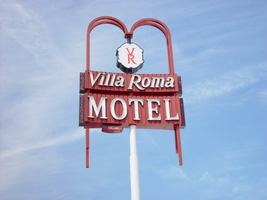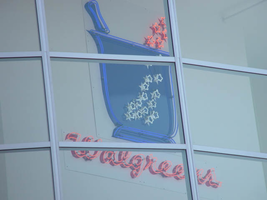Search the Special Collections and Archives Portal
Search Results
Katherine Neddenriep (Elko Convention and Vistors Authority) oral history interview conducted by Kelliann Beavers: transcript
Date
Archival Collection
Description
From the Lincy Institute "Perspectives from the COVID-19 Pandemic" Oral History Project (MS-01178) -- Business interviews file.
Text

Transcript of interview with Carol Forsythe by Sam Copeland, March 2, 1977
Date
Archival Collection
Description
Text

Transcript of interview with Rosina Goodwin by Bruce Eubank, March 15, 1978
Date
Archival Collection
Description
On March 15, 1978, Bruce Eubank interviewed Rosina Goodwin (born 1918 in Sweet Springs, Missouri) about her life in Las Vegas, Nevada. Goodwin first talks about her family background before discussing the Las Vegas Strip, the Stewart Ranch, and Twin Lakes. She also talks about schools, Boulder Dam, the atomic testing, and her work as a telephone operator. The latter part of the interview includes discussion on changes in Las Vegas, the Helldorado Parade, and changes in weather.
Text

Meeting minutes for Consolidated Student Senate University of Nevada, Las Vegas, March 4, 1996
Date
Archival Collection
Description
Text
Jon Ralston (Nevada Independent) oral history interview conducted by Kelliann Beavers and Kristian Thymianos: transcript
Date
Archival Collection
Description
From the Lincy Institute "Perspectives from the COVID-19 Pandemic" Oral History Project (MS-01178) -- Business interviews file.
Text

Photographs of Villa Roma Motel sign, Las Vegas (Nev.), 2002
Date
Archival Collection
Description
Site address: 220 Convention Center Dr
Sign details: Just west of the Somerset is the Villa Roma Motel. The only significant signage is located in the pylon side on the edge of the street. The pylon resides on the north side of Convention Center drive with the property facing east/west.
Sign condition: Structure 4 Surface 4 Lighting 4
Sign form: Pylon
Sign-specific description: Just west of the Somerset is the Villa Roma Motel. The pylon resides on the north side of the street with the property facing east/west. The sign consists of a tall white steel pole supporting two double backed cabinets, along with decorative raceways, as well as a logo cabinet. About halfway up the pole, an internally lit, double backed, cabinet cantilevers off of the south side of the pole, facing east/west also. The top of the sign is two horizontal rectangular cabinets, sitting one on top of the other, in close proximity to each other. The cabinets possess aspects of design which add a bit of flavor to plain geometric shape. The faces of the cabinet themselves are concave, bowing in along the length. The maroon surface is also fluted vertically, dividing the surface up into a pattern of vertical rectangles. Along the width of each one of the cabinets, smaller black cabinets run vertically along the edge. These cabinets are adorned with maroon graphically painted scroll work. Channel letters spell the name of the establishment on the two cabinets. The thinner, top cabinet possesses the channel letter text spelling, "Villa Roma," painted white on the interiors. The bottom cabinet's surface contains the text "Motel" in larger all capital channel letter. The interiors of both of both sets of letters are filled with neon. Attached to the bottom of the cabinet, an oval shaped cabinet resides on the north side of the cabinet. It is treated with same maroon color paint ,but the face is adorned with "vacancy" painted on the surface. "No" is spelled in neon as well as being vacancy being overlayed with neon as well. Two pairs of maroon raceways shoot out of the top of either side of the cabinet into the air, then arch inward, meeting at a common point in the center. The spot where each one of the raceway meets, a pseudo oval shaped, internally lit, double backed cabinet professes the logo for the Villa Roma Motel. The logo consists of A capital letter "V" sitting over a Letter "R" in red paint. The raceways also protrudes through the bottom of the cabinet on either side, for a short distance. The edges of the raceways are lined with incandescent bulbs.
Sign - type of display: Neon; Incandescent
Sign - media: Steel; Plastic
Sign animation: Chasing, flashing, oscillating
Notes: The text letters on the porte-cochere and entrances hold a three step animation: The incandescent bulbs all oscillate rapidly inside the letters, then steady burn on, and finally come to rest in the off position. The sequence then repeats. The main pylon sign carries several different sections which all hold different animation patterns. Inside the middle sculptural piece, the incandescent bulbs, which encrust the star shapes, oscillate in a twinkling fashion. The bulbs which border the outlying portion of the middle section chase each other, with the inner row running downward, and the outer row chasing upward. The double rows of incandescent bulbs that create the outer border, also chase each other in a similar fashion. The outer-most lane, of the double rowed bulbs, animate chasing downward, while the inner is treated with chasing animation, which chases upward. The bulbs, which encrust the bottom of the main marquee oscillate, as well as the bulbs on the widths edge of the main message center. The incandescent bulbs, which fill the text in the main marquee of the pylon, oscillate rapidly while the vertical red bars of neon, animate behind them. They star in the middle and chase out to either side illuminating all of the bars, then chase back to the center leaving them dark. They then start all illuminated, and curtain open to either side, then animates, chasing each other from either side back to the middle again. Once all illuminated, they flash off, on, off, on, then off. The marquee seems to be the one with a set sequence. On the main message board, the golden image of the cowboy animates in three stages, rocking back and forth, as if riding the bull. The letters, which adorn the tower of the building, animate in sequence. The incandescent bulbs in each letter light up individually one at a time from left to right, then once all are illuminated, they each oscillate one at a time, from left to right. They then light up continuously from left to right again one at a time, and then turn off. The letters, which run vertically on the northwest side of the tower, also have the same sequence.
Sign environment: The Villa Roma's area is interesting in itself. Convention Center Drive runs east west between the Strip and paradise road, and is home to a unique mix of signage and structures of close but not identical functions. It plays home to the Greek Isles, a bank building, dry cleaners, the Royal Casino, a giant parking lot for the Las Vegas Hilton, as well as the dying Silver Saddle. It stands as a reminder of a roadside motel that is still present, within the heart of an evolving Strip.
Surveyor: Joshua Cannaday
Survey - date completed: 2002
Sign keywords: Chasing; Pylon; Neon; Incandescent; Steel; Plastic
Mixed Content

Photographs of Walgreens signs, Las Vegas (Nev.), 2002
Date
Archival Collection
Description
Site address: 3765 S Las Vegas Blvd
Sign condition: Structure 5 Surface 3 Lighting 5
Sign form: Fascia
Sign-specific description: The Walgreens lot is shared with the Fat Burger establishment, and a strip mall of assorted shops. The lot is located on the east side of the strip, just north of the Showcase Mall. On the west elevation of the building the Walgreen's cursive, logo script spells out the word "Walgreen's". The same sign design is repeated on the north face of the building also. The two signs are crafted out of channel letter, with blue and red neon in the interior of the channel. In small black channel letters, a bit further below the logos, there are three separate sets of much smaller channel letters. These spell the phrases "Pharmacy," "24HRS," and "1 Hour Photo." These are also lined on the interior with red and blue neon. Above the entrance to the building, a wall sign crafted of neon in the shape of the "mortar and pestle" is perched above the customers head as they enter the building from the NW. The entire structure of the image of the Walgreen's mortar and pestle, as well as the outline of the exterior stars, is constructed of one giant pan channel. The body of the pestle is made of a series of blue neon tubing which starts in the center of the pan in a square shape and creates a concentric pattern, filling the pan. Small white neon stars float to the top of the sign and into the body of the sign. Below that image, on the same elevated plane, the Walgreen's script logo is written in channel letters with white neon. Below that script is written independently in neon reading "The Pharmacy that America Trusts." Facing north /south, the street-side, pylon sign for the Walgreen's establishment is a multi-use pylon. The sign boasts advertisements for several other businesses, however the Walgreen's advertisement is the most visible and dominant on the face. The architecture of the sign is mostly a giant, stucco covered vertical rectangle with a simple crown cornice molding on the top edge of the structure. The other establishments mentioned on the sign are as read from the top of the sign to the bottom: Alan Albert's Lobster House, Club Utopia, Fatburger, and a small back-lit plastic sign for ice cream and t-shirts. At the bottom of the sign, channel letters spell the phrase parking in rear, with an arrow of the same concept pointing east toward the rear of the property. The pylon is two sided, with almost the entire top of the sign belonging to Walgreen's, and sculpted almost completely out of neon. Red, horizontal neon tubes form a field of light for the neon mortar and pestle, as seen above the entrance. The red field is also home to the cursive, Walgreen's logo script, and the phrase "Open 24 hours." The mortar and pestle are a pan channel including the stars floating out of the top incorporated into its design. Crafted in blue, with white neon for the stars, the mortar handle portion sticking out of the top of the pestle animates to appear as if it is stirring, while the stars turn on and off, representing the concoction being stirred in the body of the image. The Walgreen's script is made of channel letters filled with white neon. The bottom line of the sign that reads "Open 24 Hours," is in all caps, and channel letters with white neon on the interior. They animate in sequence one word at a time from left to right. Along the vertical edge width of the sign, the words "The Plaza" are spelled in red neon.
Sign - type of display: Neon
Sign - media: Steel
Sign - non-neon treatments: Paint
Sign animation: Chasing, flashing, oscillating
Notes: The text, which resides on the southern wall and reads "Casino," is filled with incandescent bulbs that all illuminate at the same time, and oscillate. They then shut off at the same time, and then repeat. The raceways of incandescent bulbs chase each other while the neon, which surrounds the back lit, plastic, screens on this wall flash on then off. The bottom two raceways sandwiching the reflective panel chase from left to right, while the remainder of the raceways surrounding the signs, run right to left. The incandescent bulbs on the pylon chase each other gracefully up the length of the pylon. The animation is patterned so as to appear as if a section of several bulbs are pulsing its way up the towers, hugging the edge of the bulbous tops. The raceways continue around the east face of the building. The umbrellas in the plaza behind the pylon, also are animated with incandescent bulbs chasing each other downward along the raceways.
Sign manufacturer: Mikhon lighting and sign
Sign - date of installation: 1997
Sign - thematic influences: The thematic influence of the Walgreens pylon is based on the logo for the establishment, incorporated into the architectural design of a modern commercial signage. The objects represented in the logo's are based on historical peripheral tools used in the pharmaceutical trade. The mortar and pestle were instruments used by chemists and doctors to grind and pulverize chemical to me mixed together. Since Walgreen's is a pharmacy and purveyor of commonly used goods, the mortar and pestle are appropriate symbols of the property's function.
Sign - artistic significance: Walgreen's fits into a niche of locations on the Las Vegas Strip that are establishments that can be found anywhere in the United States.
Surveyor: Joshua Cannaday
Survey - date completed: 2002
Sign keywords: Flashing; Fascia; Neon; Steel; Paint
Mixed Content

Transcript of interview with Pauleen Foutz by Don Scott Kaye, February 25, 1980
Date
Archival Collection
Description
Text

Lauren M. Brown oral history interview: transcript
Date
Archival Collection
Description
Oral history interview with Lauren M. Brown conducted by Claytee D. White on February 21, 2018 for the Remembering 1 October Oral History Project. In this interview, Lauren M. Brown discusses her history with Las Vegas, Nevada, starting from when she moved to the city in 1997. She describes her experience as one of the many who stood in line to donate blood on October 2, 2017, the day after the 2017 Las Vegas mass shooting. Brown talks about what stood out on that day, including the overwhelming amount of people waiting to donate blood and the people who brought drinks and pastries for those waiting. She speaks about how that day showed her the heart of Las Vegas and changed her perspective of the city. Brown also discusses her correspondence with the Healing Garden to give ideas for the design of a permanent memorial for the tragedy.
Text

Mabel Hoggard: community interest materials (folder 1 of 3)
Date
Archival Collection
Description
Folder of materials from the Mabel Hoggard Papers (MS-00565) -- Personal papers file. This folder contains newspaper clippings, jewelry designs, a "Basic Principles of Parliamentary Law and Protocol" booklet by Marguerite Grumme (not digitized in its entirety), event programs (including Las Vegas school graduations and reunions), "Nevada Nuclear Waste Storage Investigations" booklet (November 1980), "Black Women: The Unsung Heroines, Black History Week 1979" booklet, and other miscellaneous booklets (not all are digitized in their entirety).
Mixed Content
